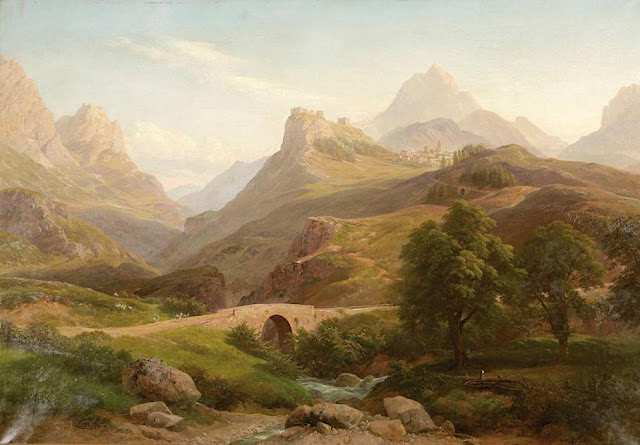JOHN SINGER SARGENT (1856-1925)
La Marmolada (3,343m)
Italie
in Open valley Italy, aquarelle, commentée et datée sur le coté gauche 1869
La montagne
La Marmolada (3343 m) est le plus haut sommet des Dolomites. Elle est également appelée la « reine des Dolomites ». Elle constitue l'un des neuf lieux appartenant au site Les Dolomites, déclaré en 2009 site du patrimoine mondial par l'UNESCO. Le nom de Marmolada pourrait provenir du mot latin marmor, signifiant « marbre » ou « pierre » au sens plus général, ou bien d'une racine indo-européenne attestée par le grec marmar, signifiant « briller » ou « scintiller », en référence au glacier qui s'étend sur son versant nord.
La Marmolada est située entre le val di Fassa et le Cordevole, à la frontière entre les provinces de Belluno et de Trente, au nord-est de l'Italie. Son sommet est constitué de plusieurs pics, dont Punta Penia (3 342 ou 3 343 m, point culminant), Punta Rocca (3 309 m), Punta Ombretta (3 230 m), Monte Serauta (3 069 m), et Pizzo Serauta (3 035 m). Le glacier homonyme est le plus étendu des Dolomites. Lorsque la Première Guerre mondiale éclate, la frontière austro-italienne passe alors le long de la Marmolada, qui devient le théâtre de combats, comme le confirment les positions encore visibles sur le versant nord. Aujourd'hui, la montagne est la destination de skieurs et d'alpinistes, et les localités voisines comme Canazei et Malga Ciapela sont des centres touristiques renommés, actifs toute l'année. Jusqu'en 2003, les conditions du glacier permettaient la pratique du ski d'été sur deux ou trois pistes auxquelles on accédait par un téléphérique et par deux remontées mécaniques, commençant à 2 850 m d'altitude et atteignant les 3 000 m.
Le peintre
John Singer Sargent,
est un peintre américain qui vécut essentiellement en Europe. Élève de
Carolus-Duran, de Léon Bonnat et d'Adolphe Yvon, il étudie à l'École des
beaux-arts de Paris. Il est ami ou proche de grands artistes de
l'époque, comme Claude Monet, Paul Helleu, Albert Besnard, Gabriel Fauré
ou encore Edmund Gosse. Sargent est particulièrement connu pour son
habileté dans les portraits, caractérisés par un style sophistiqué, une
virtuosité visuelle et une certaine audace théâtrale. Il réalise sur
commande des portraits d'hommes et de femmes les plus célèbres, riches
ou puissants d'Europe ou des États-Unis,. Au cours de sa carrière, il
composa environ neuf cents toiles et plus de deux mille aquarelles,
ainsi que d'innombrables croquis et dessins. Son œuvre documente ses
voyages à travers le monde, de Venise au Tyrol, de Corfou au
Moyen-Orient, ou encore du Montana à la Floride. Il fut actif en France
et en Angleterre et peignit des compositions à personnages, compositions
religieuses, scènes de genre, figures, portraits, intérieurs, paysages,
marines, des compositions murales, à la gouache, à l'aquarelle. Ce fut
aussi un dessinateur. Il est proche du courant de l'impressionnisme
américain.
________________________________________
2025 - Gravir les montagnes en peintures ..
Un blog de Francis Rousseau
%20Dolomites%20%20(3343m)%20Open%20valley-%20Italy%20%20jpg.jpg)
-%20Peak%20in%20Sunloght%20(%20Grossglkner%20%3F.jpg)
-%20Elbsee%20pres%20de%20PArtenkirchen%201826-%201826%20Munich%20Neue%20Picakothek%20.png)


-_Der_Rosengarten_von_Sankt_Cyprian-%20Dolomites.jpg)

-%20Civetta%20.png)
-Cinque-Torre-Bei-cortina,-Su%CC%88d%20tirol.jpg)










